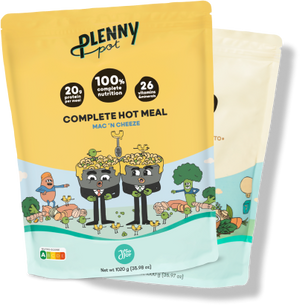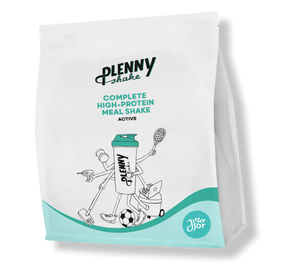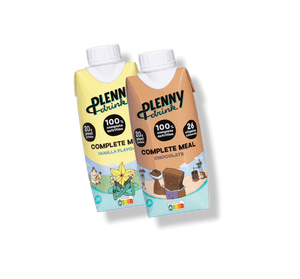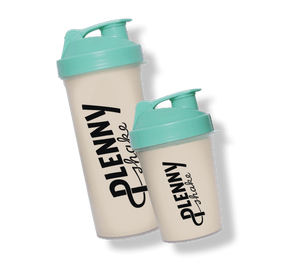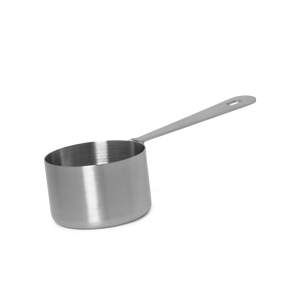
Plenny Shake Active is a nutritionally complete meal that is high in protein and fibre, contains omega 3, and is low in sugar.
Because of the high protein content of 35 grams per meal, it’s well suited for anyone who likes to be active, work out, and wants to maximise muscle protein synthesis! Bring on those muscles!
One meal of Plenny Shake Active provides you with all macronutrients and micronutrients your body needs to function properly: proteins, carbohydrates, fats, and all 26 essential vitamins and minerals.
And last but not least, some small but powerful ingredients to make Plenny Shake Active even more special: probiotics, choline, and algae.
One portion contains 400 kcal, of which 32% comes from carbohydrates, 30% from fat, 35% from protein and 3% from fibre.
The shakes are available in four tasty flavours; Vanilla, Strawberry, Banana, and Chocolate.
Nutritional breakdown
Per portion of Plenny Shake Active 3.1 Vanilla
|
Nutrition |
Value |
|
Energy |
400 kcal/1674 KJ |
|
Fat |
13 grams |
|
From which saturated fats |
1.6 grams |
|
Carbohydrates |
32 grams |
|
From which sugar |
3.8 grams |
|
Fibres |
6.7 grams |
|
Protein |
35 grams |
|
Salt |
1.1 grams |
Ingredients
- Oat flour
- Soy flour
- Sunflower oil
- Soy protein isolate
- Inulin
- Ground golden flax seeds
- Vitamin and mineral mix
- Sweetener: sucralose
- Probiotics: Bacillus Coagulans
- Freeze-dried T. chuii microalgae
- Depending on the flavour: Fruit powder, cocoa powder, beetroot powder, beta-carotene, and aromas when applicable.
Macronutrients
Proteins
The protein in Plenny Shake Active comes from soy protein isolate, oats, soy flour and flaxseed. Each portion of Plenny Shake provides 35 grams of protein, so you’ll easily hit the daily recommended protein intake for an active person. Besides that, protein keeps your stomach full for longer because protein takes longer to digest than, for example, carbohydrates.
We use soy protein isolate as the main protein source because of its high digestibility and absorption rate. Want to read more about plant-based protein? This article will tell you all about it! [1,2]
The combination of protein sources in the Plenny Shake Active results in the following amino acid profile:
|
Amino Acid |
Mg per portion* |
% from the WHO daily recommended intakes** |
|
Alanine |
1620 |
- |
|
Arginine |
2800 |
- |
|
Aspartic Acid |
4220 |
- |
|
Glutamic Acid |
7250 |
- |
|
Glycine |
1600 |
- |
|
Hystidine |
980 |
140 % |
|
Isoleucine |
1720 |
123 % |
|
Leucine |
2930 |
107% |
|
Lysine |
2740 |
130% |
|
Methionine + Cysteine |
1030 |
98% |
|
Phenylalanine + Tyrosine |
3280 |
187% |
|
Proline |
2040 |
- |
|
Serine |
1930 |
- |
|
Threonine |
1420 |
135% |
|
Tryptophan |
446 |
159 % |
|
Valine |
1860 |
102 % |
*latest laboratory results
**based on an average adult (70kg). The requirements are determined by the person’s weight.
As you can see, Plenny Shake Active meets the daily recommended intakes the World Health Organization has established for all nine essential amino acids, helping you meet your personal protein needs.
Fats
The ingredients providing heart-friendly fats to our Plenny Shake Actives are sunflower oil, flaxseed, and soy flour. Omega 3 and 6 are fatty acids and indisputably essential nutrients that the body cannot sufficiently produce on its own. Fat is a major energy source for your body, and it helps you absorb vitamins and nutrients.
- The sunflower oil we use for Plenny Shake Active has mainly polyunsaturated fats.
- We add golden flaxseed because of its content of α-Linolenic acid (omega-3). Each portion contains 0,7g of omega 3.
- The soy flour helps a little bit with the fat content of the meal.
The EFSA advises that 250 mg of omega-3 should be ingested daily at the very least to maintain normal heart function.
Carbohydrates
Most of the carbohydrates in Plenny Shake Active come from oats, which are especially interesting because of their beta-glucans content and low Glycemic Index (GI). This means that blood glucose levels will fluctuate less, and so will your energy levels, thanks to their fibre content. As a second energy source, soy flour wins this place [6,8,9].
Fibres
The main sources of fibres in our meals are inulin, oats and flaxseed. They help in lowering blood pressure and smoothen your digestion. In particular, inulin, extracted from chicory, is added to achieve a wider variety of fibre sources and upgrade the type of fibre per portion. If you are curious to know more, check out this blog dedicated to gut health and fibres [10,11]!
Micronutrients
The vitamin and mineral mix that we add to the meals provides all the needed 26 micronutrients. We use the most bioavailable forms of micronutrients so that your body can absorb each bit of all the vitamins and minerals easily and at the highest rate.
For instance, we add vitamin D in the form of cholecalciferol (D3) and vitamin K in the form of menaquinone-7 (K2 MK7). You can read more about our micronutrient mix here.
Per portion (98g)
|
Vitamins and Minerals |
Amounts |
RI%* |
|
Vitamin A |
160 μg |
20%* |
|
Vitamin D |
5.0 μg |
100%* |
|
Vitamin E |
4.0 mg |
33%* |
|
Vitamin K |
16 μg |
21%* |
|
Vitamin C |
40 mg |
50%* |
|
Thiamin |
0.4 mg |
36%* |
|
Riboflavin |
0.32 mg |
23%* |
|
Niacin |
3.6 mg |
23%* |
|
Vitamin B6 |
0.40 mg |
29%* |
|
Folic Acid |
60 μg |
30%* |
|
Vitamina B12 |
3.2 μg |
128%* |
|
Biotin |
10 μg |
20%* |
|
Pantothenic acid |
1.2 mg |
20%* |
|
Potassium |
400 mg |
20%* |
|
Chloride |
279 mg |
35%* |
|
Calcium |
185 mg |
23%* |
|
Phosphorus |
140 mg |
20%* |
|
Magnesium |
75 mg |
20%* |
|
Iron |
3.2mg |
23%* |
|
Zinc |
2.0 mg |
20%* |
|
Copper |
0.40 mg |
40%* |
|
Manganese |
1.0 mg |
50%* |
|
Selenium |
18 μg |
33%* |
|
Chromium |
8.0 μg |
20%* |
|
Molybdenum |
13 μg |
26%* |
|
Iodine |
30 μg |
20%* |
*% of the daily reference intake (RI) for vitamins and minerals
** Reference intake of an average adult (8400 kJ/2000 kcal)
Last but not least; Choline, probiotics, and algae
We wanted to add extra functional benefits to our meals, for which we dug into the best ingredients out there and decided to add choline and probiotics.
Choline is a small organic molecule that your body needs to function properly. It is an essential nutrient because it is a key element in metabolic pathways that govern our bodies and run our cells; more specifically, it carries important building bricks called methyl groups, which are very important in food processes and in the brain, for example [12-16].
Moreover, probiotics came to our thoughts because of their ability to possibly enhance and strengthen our gut microbiome. Because of the high fibre content in Plenny Shakes, they have a symbiotic effect. This means that probiotics become more resistant and provide a stronger health effect thanks to the fibres they eat and live from. So one ingredient strengthens the other one! Sweet, right [17]?
Plenny Shake Active v3.1 contains freeze-dried microalgae: Tetraselmis chuii. This alga has a lot of the antioxidant “superoxide dismutase” (SOD). Our body naturally produces this antioxidant, but as we age, we produce less and the quantity decreases. SOD is the first antioxidant in the line of defence against ROS: reactive oxygen species. These can damage proteins, lipids and genetic material [4]. When there are too many ROS and too few antioxidants to battle them, the antioxidant defence system gets overwhelmed, and the body will experience oxidative stress [18].
Many diseases, including cancer, atherosclerosis, diabetes, chronic inflammation, neurodegenerative disorders, and cognitive disorders, are thought to be influenced by oxidative stress. But studies have shown the advantages of antioxidant supplementation in reducing oxidative stress. [19]
Can’t wait to benefit from the tasty and nutritional advantages of the Plenny Shake Active v3.1? Go here!
Sources
- WHO | Protein and amino acid requirements in human nutrition [Internet]. WHO. World Health Organization; [cited 2020 Apr 7]. Available from: http://www.who.int/nutrition/publications/nutrientrequirements/WHO_TRS_935/en/
- Pendick D. How much protein do you need every day? [Internet]. Harvard Health Blog. 2015 [cited 2020 Apr 9]. Available from: https://www.health.harvard.edu/blog/how-much-protein-do-you-need-every-day-201506188096
- Balić A, Vlašić D, Žužul K, Marinović B, Bukvić Mokos Z. Omega-3 Versus Omega-6 Polyunsaturated Fatty Acids in the Prevention and Treatment of Inflammatory Skin Diseases. Int J Mol Sci [Internet]. 2020 Jan 23 [cited 2020 Aug 28];21(3). Available from: https://www.ncbi.nlm.nih.gov/pmc/articles/PMC7037798/
- Boston 677 Huntington Avenue, Ma 02115 +1495‑1000. Types of Fat [Internet]. The Nutrition Source. 2014 [cited 2020 Apr 9]. Available from: https://www.hsph.harvard.edu/nutritionsource/what-should-you-eat/fats-and-cholesterol/types-of-fat/
- WHO | Fats and fatty acids in human nutrition [Internet]. WHO. World Health Organization; [cited 2020 Apr 7]. Available from: https://www.who.int/nutrition/publications/nutrientrequirements/fatsandfattyacids_humannutrition/en/
- Oats | The Nutrition Source | Harvard T.H. Chan School of Public Health [Internet]. [cited 2020 Apr 9]. Available from: https://www.hsph.harvard.edu/nutritionsource/food-features/oats/
- Slavin J, Carlson J. Carbohydrates1. Adv Nutr. 2014 Nov 3;5(6):760–1.
- Dietary Reference Intakes for Energy, Carbohydrate, Fiber, Fat, Fatty Acids, Cholesterol, Protein, and Amino Acids | The National Academies Press [Internet]. [cited 2020 Apr 3]. Available from: https://www.nap.edu/download/10490
- Holscher HD. Dietary fiber and prebiotics and the gastrointestinal microbiota. Gut Microbes. 2017 04;8(2):172–84.
- Whole Grains, Refined Grains, and Dietary Fiber | American Heart Association [Internet]. [cited 2020 Apr 9]. Available from: https://www.heart.org/en/healthy-living/healthy-eating/eat-smart/nutrition-basics/whole-grains-refined-grains-and-dietary-fiber#.WVVm4RMrIdU
- Zeisel SH, Corbin KD. Choline. In: Erdman JW, Macdonald IA, Zeisel SH, eds. Present Knowledge in Nutrition. 10th ed. Washington, DC: Wiley-Blackwell; 2012:405-18.
- Institute of Medicine. Food and Nutrition Board. Dietary Reference Intakes: Thiamin, Riboflavin, Niacin, Vitamin B6, Folate, Vitamin B12, Pantothenic Acid, Biotin, and Choline. Washington, DC: National Academy Press; 1998.
- Zeisel SH. Choline. In: Coates PM, Betz JM, Blackman MR, et al., eds. Encyclopedia of Dietary Supplements. 2nd ed. London and New York: Informa Healthcare; 2010:136-43
- Zeisel SH. Choline. In: Ross AC, Caballero B, Cousins RJ, Tucker KL, Ziegler TR, eds. Modern Nutrition in Health and Disease. 11th ed. Baltimore, MD: Lippincott Williams & Wilkins; 2014:416-26.
- Corbin KD, Zeisel SH. Choline metabolism provides novel insights into nonalcoholic fatty liver disease and its progression. Curr Opin Gastroenterol 2012;28:159-65. [PubMed abstract]
- Holscher H. D. (2017). Dietary fiber and prebiotics and the gastrointestinal microbiota. Gut microbes, 8(2), 172–184. https://doi.org/10.1080/19490976.2017.1290756
- Sies, H., 2017. Hydrogen peroxide as a central redox signaling molecule in physiological oxidative stress: Oxidative eustress. Redox biology, 11, pp.613-619.
- Stephenie, S., Chang, Y.P., Gnanasekaran, A., Esa, N.M. and Gnanaraj, C., 2020. An insight on superoxide dismutase (SOD) from plants for mammalian health enhancement. Journal of Functional Foods, 68, p.103917.














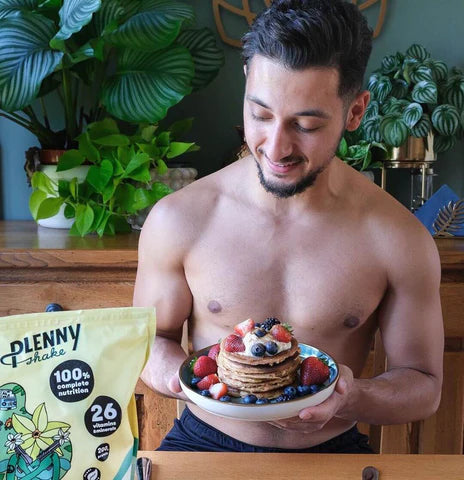



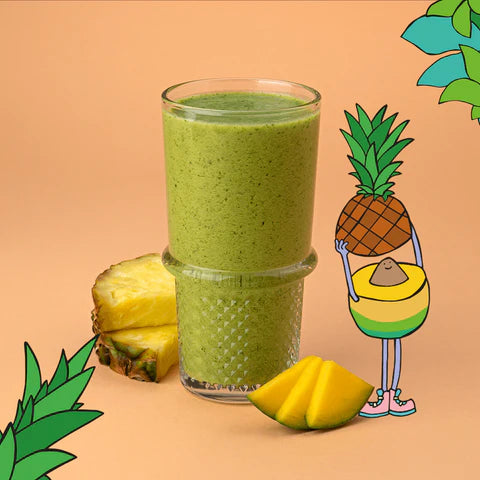


 Product added to cart
Product added to cart



